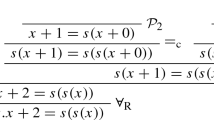Abstract
The first-order intuitionistic logic is a formal theory from the family of constructive logics. In intuitionistic logic, it is possible to extract a particular example x = a and a proof of a formula P(a) from a proof of a formula ∃xP(x). Owing to this feature, intuitionistic logic has many applications in mathematics and computer science. Many modern proof assistants include automated tactics for the first-order intuitionistic logic, which simplify the task of solving challenging problems, such as formal verification of software, hardware, and protocols. In this paper, a new theorem prover (called WhaleProver) for full first-order intuitionistic logic is presented. Testing on the ILTP benchmarking library has shown that WhaleProver performance is comparable with the state-of-the-art intuitionistic provers. Our prover has solved more than 800 problems from the ILTP version 1.1.2. Some of them are intractable for other provers. WhaleProver is based on the inverse method proposed by S.Yu. Maslov. We introduce an intuitionistic inverse method calculus which is, in turn, a special kind of sequent calculus. It is also described how to adopt for this calculus several existing proof search strategies proposed for different logical calculi by S.Yu. Maslov, V.P. Orevkov, A.A. Voronkov, and others. In addition, a new proof search strategy is proposed that allows one to avoid redundant inferences. The paper includes results of experiments with WhaleProver on the ILTP library. We believe that Whale- Prover can be used as a test bench for different inference procedures and strategies, as well as for educational purposes.
Similar content being viewed by others
References
Constable, R.L., On building constructive formal theories of computation. noting the roles of Turing, Church, and Brouwer, Proc. of the 27th Annu. IEEE/ACM Symp. on Logic in Computer Science (LICS’ 12), 2012, pp. 2–8.
Schmitt, S., Lorigo, L., Kreitz, C., and Nogin, A., JProver: Integrating connection-based theorem proving into interactive proof assistant, Lect. Notes Comput. Sci., 2001, vol. 2083, pp. 421–426.
The ILTP Library. Provers and Results. http://iltp.de/results.html
Raths, T., Otten, J., and Kreitz, C., The ILTP Library: Benchmarking theorem provers for intuitionistic logic, automated reasoning with analytic tableaux and related methods, Lect. Notes Artificial Intelligence, 2005, vol. 3702, pp. 333–337.
Pavlov, V. and Pak, V., The inverse method and firstorder logic theorem proving, Nonlinear Dynamics Appl., 2014, vol. 20, pp. 127–135.
Pavlov, V.A., Efficient software implementation of Maslov’s inverse method for intuitionistic logic, Nauchno-Tekh. Vedomosti. S.-Peterb. Politekh. Univ. Informatika. Telekommunikatsii. Upravlenie, 2017, no. 1, pp. 49–62.
Maslov, S.Yu., The inverse method for establishing deducibility for logical calculi, Proc. Steklov Inst. Math., 1971, vol. 98, pp. 25–95.
Degtyarev, A. and Voronkov, A., The Inverse Method. Handbook of Automated Reasoning, Amsterdam: Elsevier, 2001.
Lifschitz, V., What is the inverse method?, J. Automated Reasoning, 1989, vol. 5, no. 1, pp. 1–23.
Mints, G., Decidability of the class E by Maslov’s inverse method, Lect. Notes Comput. Sci., 2010, vol. 6300, pp. 529–537.
Maslov, S.Yu., Deduction search in calculi of general type, J. Soviet Math., 1976, vol. 6, no. 4, pp. 395–400.
Maslov, S.Yu., The inverse method and tactics for establishing deducibility for a calculus with functional symbols, Proc. Steklov Inst. Math., 1974, vol. 121, pp. 11–60.
Maslov, S.Yu., Deduction-searching tactics based on unification of the order of memebers in general-type calculi, Seminars in Mathematics. Steklov Math. Inst., 1971, vol.16.
McLaughlin, S. and Pfenning, F., Efficient intuitionistic theorem proving with the polarized inverse method, 22nd Int. Conf. on Automated Deduction (CADE-22), Montreal, 2009, vol. 5663, pp. 230–244.
Mints, G., Resolution strategies for the intuitionistic logic, in Constraint Programming, NATO ASI Series, vol. 131, Springer, 1994.
Tammet, T., A resolution theorem prover for intuitionistic logic, 13th Int. Conf. on Automated Deduction (CADE-13), New Brunswick, NJ, 1996, vol. 1104, pp. 2–16.
Voronkov, A., Theorem proving in non-standard logics based on the inverse method, 11th Int. Conf. on Automated Deduction (CADE-11), Saratoga Springs, NY, 1992, vol. 607, pp. 648–662.
Kleene, S.C., Permutability of inferences in Gentzen’s calculi LK and LJ, Mem. Am. Math. Soc., 1952, vol. 10, pp. 1–26.
Dragalin, A.G., Matematicheskii intuitsionizm. Vvedenie v teoriyu dokazatel’stv (Mathematical Intuitionism. Introduction to Theory of Proofs), Moscow: Nauka, 1979.
Orevkov, V.P., Inverse method for searching inference for Skolem formulas of predicate calculus, in Logicheskoe programmirovanie i Visual Prolog (Logical Programming and Visual Prolog), St. Petersburg: BKhVPeterburg, 2003, pp. 952–965.
McCune, W., Prover9 and Mace4, 2005–2010. www.cs.unm.edu/mccune/mace4/.
Imogen GitHub page. https://github.com/seanmcl/imogen.
Sutcliffe, G. and Suttner, C., Evaluating general purpose automated theorem proving systems, Artificial Intelligence, 2001, vol. 131, nos. 1–2.
Otten, J., Non-clausal connection-based theorem proving in intuitionistic first-order logic, Proc. of the 2nd Int. Workshop on Automated Reasoning in Quantified Non-Classical Logics (ARQNL/IJCAR 2016), CEUR Workshop Proceedings, 2016, vol. 1770, pp. 9–20. http://ceur-ws.org/Vol-1770/
Kunze, F., Towards the integration of an intuitionistic first-order prover into Coq, Proc. of the 1st Int. Workshop Hammers for Type Theories (HaTT 2016), 2016. https://arxiv.org/abs/1606.05948.
Author information
Authors and Affiliations
Corresponding author
Additional information
Original Russian Text © V.A. Pavlov, V.G. Pak, 2018, published in Programmirovanie, 2018, Vol. 44, No. 1.
Rights and permissions
About this article
Cite this article
Pavlov, V.A., Pak, V.G. Theorem Prover for Intuitionistic Logic Based on the Inverse Method. Program Comput Soft 44, 51–61 (2018). https://doi.org/10.1134/S036176881801005X
Received:
Published:
Issue Date:
DOI: https://doi.org/10.1134/S036176881801005X




